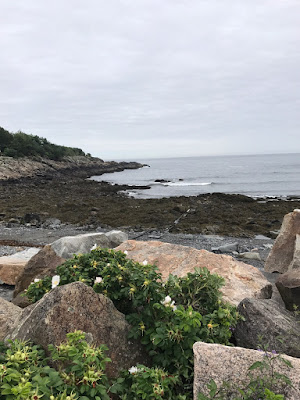I just finished a new reduction block print, and I thought I'd demonstrate the process. It may seem like a complicated process, but once you see the steps, I think it will make more sense.
These are the materials I use most of the time, as I can print at home without a printing press.
Soft-cut block (flexible, rubbery material, easy to carve, durable)
Rives Lightweight paper
Pins and tabs for registration (Ternes Burton Co.)
cardboard template
Akua Intaglio inks (works great for block prints, cleans up with soap and water)
Brayer- for rolling on the ink evenly
Baren for rubbing back of paper---hands work fine too
Assortment of carving nibs and handle
tracing paper---for transferring image to the block
soft pencil, X-acto knife, ruler
Sharpie marker
Step 1 Choose your image and block size
Remember that you are going to be layering the colors of inks, so a monochromatic or analogous color scheme work the best. I usually try to print the colors from lightest to darkest.
Draw your image on tracing paper, using a soft pencil. Flip the drawing onto the block with the pencil side down, and gently rub the back of the tracing paper with your hand or a baren. Be careful not to move the paper once you start transferring. When you are done, outline the drawing with a permanent marker, like a Sharpie Fine Line. This will keep your image from rubbing off during the process of carving, printing, and cleaning the block.
Step 2 Pins and Tabs---Registration
This is the easiest way too make sure all the color layers of your prints line up perfectly. Cut up your paper so you have at least a 1-2" border all around the image size. Decide on the number of prints that you want in your edition. I usually do at least 12.
Lay your block onto a piece of cardboard or mat board that is larger than your block size, and trace around the block. Cut out the area inside the lines with an X-acto knife and ruler, and make sure your block fits securely into the space. Attach the pins to the cardboard with tape. One by one, set each piece of paper over the block, and line up the tabs with the pins. Tape the tabs onto the paper.
Step 3 The first color
If you want to leave any areas white (the color of the paper), cut away those white areas with your carving tool first.
Place your block into the cardboard template, and mix up your first color. I use a piece of thick plastic to mix my inks. I use small scraps of mat board to stir up the Akua inks throughly. You can also use Speedball block printing inks for this process, but they tend to dry very quickly.
Using a brayer, roll the ink evenly onto your block. Connect your pins onto the tabs, and lay your paper down onto the inked block. Rub the back of the paper with a baren or your palm. Continue inking and printing until you have finished your first color.
Step 4 Carve away the areas on your block that you wish to remain the first color. Mix up the next color, and print the second layer over the first. Sometimes I will create a blend by putting two colors side by side on my brayer, and rolling them carefully onto the block.
In the above image, I have printed 2 layers---a light green first, and a blend of light purple and gray.
The sky area was cut away before I did the first color, leaving it the white of the paper.
Continue printing and carving away until your last color is done.
Just to make this more confusing, on this layer of green, I made a parchment paper stencil to block off the gray house and stone wall areas, so that the gray would not get any green on it. Each time I inked the block, I would lay the stencil back down.
Here is what the prints looked like at this stage.
Printing the darker green layer
Carving the final layer
The finished image
Hanging the prints up to dry. You can also see the cardboard template that the plate is resting in, as well as the metal pins, and the plastic tabs on each print.
When I first started experimenting with reduction block printing, I kept it really simple--2 or 3 colors at most. I worked with small blocks, and didn't use pins and tabs for registration. I just laid the little block on top of the previous color. That's a fun and easy way to try this technique!





















































